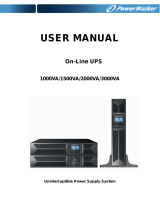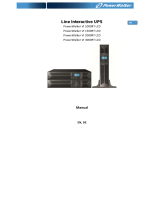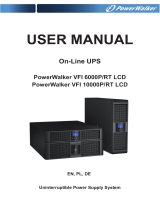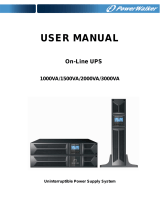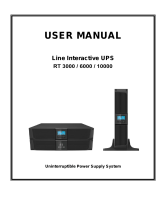Page is loading ...

USER MANUAL
On-Line UPS
PowerWalker VFI 6000RT LCD
PowerWalker VFI 6000P/RT LCD
PowerWalker VFI 10000RT LCD
PowerWalker VFI 10000P/RT LCD
Uninterruptible Power Supply System

Contents
1. Introduction ......................................................................................... 1
2. Safety Warnings .................................................................................. 4
2.1 Installation ...................................................................................... 4
2.2 Operation ........................................................................................ 5
2.3 Maintenance, servicing and faults ................................................... 6
2.4 Transport ........................................................................................ 7
2.5 Storage ........................................................................................... 7
2.6 Standards ....................................................................................... 7
3. Installation ........................................................................................... 9
3.1 Inspecting the Equipment ................................................................ 9
3.2 Unpacking the carton ...................................................................... 9
3.3 UPS Rear Panel ........................................................................... 12
3.4 UPS Front Panel ........................................................................... 13
3.5 Rack mount Setup ........................................................................ 14
3.6 Tower Setup .................................................................................. 18
3.7 Installation of UPS with AC inputs ................................................. 19
4. Power cables connection & Startup ................................................. 21
4.1 Access to terminal block ................................................................ 22
4.2 Common input sources connection ............................................... 22
4.3 Separate input sources connection ............................................... 23
4.4 Frequency converter connection ................................................... 24
4.5 UPS Initial Startup ......................................................................... 24
4.6 Parallel Installation and Operation ................................................. 25
5. Operation........................................................................................... 31
5.1 Display Panel ................................................................................ 31
5.2 Operating mode ............................................................................ 33
5.3 Turning on and Turning off UPS .................................................... 36
5.4 LCD operation .............................................................................. 38
6. UPS Maintenance .............................................................................. 47
6.1 UPS and Battery Care .................................................................. 47

6.2 Transporting the UPS .................................................................... 47
6.3 Storing the UPS and Batteries ....................................................... 48
6.4 Testing Batteries ........................................................................... 48
6.5 Recycling the Used Battery or UPS ............................................... 49
7. Specifications ................................................................................... 50
7.1 Electrical specification ................................................................... 50
7.2 Dimension and Weight .................................................................. 51
7.3 Operating Environment ................................................................. 51
8. Troubleshooting ................................................................................ 52
8.1 Typical Alarms and Conditions ...................................................... 52
9. Communication ................................................................................. 57
9.1 RS-232 and USB Communication Ports ........................................ 57
9.2 Network Management Card (Optional) .......................................... 59
9.3 UPS Management Software .......................................................... 59
9.4 REPO Function ............................................................................. 60


1
1. Introduction
This Online R/T Series is an uninterruptible power supply
incorporating double-conversion technology. It provides perfect
protection specifically for computer equipment, communication
systems to computerized instruments. It protects your sensitive
electronic equipment from basic power problems such as power
failures, power sags, power surges, brownout, and line noise.
Power outages can occur when you least expect them and power
quality can be erratic. These power problems have the potential to
corrupt critical data, destroy unsaved work sessions, and damage
hardware causing hours of lost productivity and expensive
repairs.
With the Online R/T UPS, you can safely eliminate the effects of
power disturbances and guard the integrity of your equipment. The
UPS can handle array--network devices flexibility that makes it the
best choice for protect your LANs, servers, workstations, and other
electrical equipment.
Online R/T UPS as Rack installation:
Figure 1-1: Online R/T 6K UPS

2
Figure 1-2: Online R/T 10K UPS
Online R/T UPS as Tower installation.
Figure 1-3: Online R/T 6K UPS Figure 1-4: Online R/T 10K UPS

3
Providing outstanding performance and reliability, the UPS’s unique
benefits include:
Online UPS design with pure sine wave output.
True online double-conversion technology with high power
density, utility frequency independence, and generator
compatibility.
Intelligent Battery Management technology that uses advanced
battery management to increase battery service life, optimize
recharge time.
Selectable High Efficiency mode of operation.
Start-on-battery capability for powering up the UPS even if
utility power is not available.
Standard communication options: one RS-232 communication
port, one USB communication port.
Optional connectivity cards with enhanced communication
capabilities.
Extended runtime with up to four Extended Battery Modules
(EBMs) per UPS.
Optional installation method Rack & Tower.
Remote shutdown control through the Remote Emergent
Power-off (REPO) port.
Maintenances are simplified by allowing the safe replacement
of batteries without powering down the UPS.
Parallel with another Online R/T UPS, max amount is 2.
Optional Rack Slider.
PDU is standard configuration with maintenance bypass
switch.

4
2. Safety Warnings
IMPORTANT SAFETY INSTRUCTIONS FOR EACH STEP SAVE
THESE INSTRRUCTIONS.
2.1 Installation
Condensation may occur if the UPS is moved directly from a
cold to a warm environment. The UPS must be absolutely dry
before being installed. Please allow an acclimatization time of
at least two hours.
Do not install the UPS near water or in damp environment.
Do not install the UPS where it would be exposed to direct
sunlight or near heat.
Do not block ventilation openings in the UPS’s housing.
Place cables in such a way that no one can step on or trip over
them.
UPS has provided earthed terminal, in the final installed system
configuration, equipotent earth bonding to the external UPS
battery cabinets.
An integral single emergency switching device which prevents
further supply to the load by the UPS in any operation mode
should be provided in the building wiring installation.
An appropriate disconnect device as short-circuit backup
protection should be provided in the building wiring installation.
For three-phase equipment connection to an IT power system,
a four-pole device which disconnect all phase conductors and
CAUTION:
Before performing the procedures in this document, read and follow
the safety instructions and important regulatory information in your
Safety, Environmental, and Regulatory Information document.

5
the neutral conductor should be provided in the building wiring
installation.
This is permanently connected equipment , it must be installed
by qualified maintenance personnel.
For permanently connected equipment: make sure that a
readily accessible disconnect device is incorporated in the
building installation wiring.
To reduce the risk of fire, connect only to a circuit provided with
branch circuit overcurrent protection with an ampere rating in
accordance with the IEC/EN 60934 standard or your local
electrical code and have a contact air gap of at least 3 mm.
Uninterruptible power supply
output power
240V
6K
40 amp
2-pole circuit breaker
10K
63 amp
2-pole circuit breaker
You can connect four extended battery modules to the
uninterruptible power supply.
Earthing connection is essential before connecting to the
building wiring terminal.
2.2 Operation
Do not disconnect the earth conductor cable from the UPS or
the building wiring terminals in any time since this would cancel
the protective earthing of the UPS system and all connected
loads.
The UPS output terminal block may be electrically active even if
the UPS system is not connected to the building wiring
terminal.
In order to completely disconnect the UPS, firstly press the
OFF button, and then disconnect the mains lead.

6
Ensure that no liquid or other foreign objects can enter the
UPS.
The UPS can be operated by any individual without previous
experience.
2.3 Maintenance, servicing and faults
The UPS operates with hazardous voltages. Maintenance
should be carried out only by qualified maintenance personnel.
Caution - risk of electric shock. Even after the unit is
disconnected from the mains power supply (building wiring
terminal), components inside the UPS are still connected to the
battery which have potentially dangerous.
Before carrying out any kind of service and/or maintenance,
please disconnect the batteries. Verify that no current is
present and no hazardous voltage exist in the capacitor or BUS
capacitor terminals.
Batteries must be replaced only by qualified personnel.
Caution – the risk of electric shock. The battery circuit is not
isolated from the input voltage. Hazardous voltage may occur
between the battery terminals and the ground. Verify that no
voltage is present before servicing!
Batteries have a high short-circuit current and pose a risk of
shock. Take all precautionary measures specified as below and
any other measures necessary when working with batteries:
1) Remove all jewellery, wristwatches, rings and other metal
objects
2) Use only tools with insulated grips and handles.
3) When changing batteries, replace with the same quantity
and the same type of batteries.
4) Do not attempt to dispose of batteries by burning them. It
could cause explosion.

7
5) Do not open or destroy batteries. Effluent electrolyte can
cause injury to the skin and eyes. It may be toxic.
Please replace the fuse only with the same type and of the
same amperage in order to avoid fire hazards.
Do not dismantle the UPS, except the qualified maintenance
personnel.
2.4 Transport
Please transport the UPS only in the original packaging (to
protect against shock and impact).
2.5 Storage
The UPS must be stockpiled in the room where is ventilated
and dry.
2.6 Standards
* Safety
IEC/EN 62040-1
* EMI
Conducted Emission.........................:IEC/EN 62040-2 Category C2
Radiated Emission............................:IEC/EN 62040-2 Category C2
*EMS
ESD................................................:IEC/EN 61000-4-2
Level 4
RS..................................................:IEC/EN 61000-4-3 Level 3
EFT................................................ :IEC/EN 61000-4-4
Level 4
SURGE......................................... :IEC/EN 61000-4-5 Level 4
CS................................................. :IEC/EN 61000-4-6 Level 3

8
Power-frequency Magnetic field.... :IEC/EN 61000-4-8
Level 3
Low Frequency Signals..................:IEC/EN 61000-2-2
Warning: This is a product for commercial and industrial application
in the second environment-installation restrictions or additional
measures may be needed to prevent disturbances.

9
3. Installation
This chapter explains:
Equipment inspection
Unpacking the cabinet
Checking the Accessory
UPS setup and installation
Connecting the internal battery
Connecting the EBM(Extended Battery Modules)
Installation requirements
3.1 Inspecting the Equipment
If any equipment has been damaged during shipment, keep the
shipping cartons and packing materials for the carrier or place of
purchase and file a claim for shipping damage. If you discover
damage after acceptance, file a claim for concealed damage.
Note: Check the battery recharge date on the shipping carton label.
If the date has passed and the batteries were never recharged, do
not use the UPS. Contact your service representative.
3.2 Unpacking the carton
CAUTION: If the carton unpacks in a low-temperature of
environment it may cause condensation of moisture in or on the
cabinet of UPS. Do not install the UPS until the inside and outside of
the cabinet is absolutely dry to prevent hazard of electric shock.
CAUTION: The cabinet is heavy. Refer following instruction to
unpack and move the cabinet from packing carton.
Be careful when moving and opening the carton. The unpacking
steps are shown as below:

10
Step 1:
Open the outer carton and remove the accessories out of the
carton (see Figure 3-1&3-2).
Online R/T 6K UPS:
Figure 3-1: Unpacking the carton of 6K UPS
Online R/T 10K UPS
Figure 3-2: Unpacking the carton of 10K UPS

11
Step 2:
With one person on each side, carefully lift the cabinet out of the
outer carton using the handles on the cardboard and set it on a flat,
stable surface (see Figure 3-3&3-4).
Place the cabinet in a protected area that has adequate airflow and
is free of humidity, flammable gas, and corrosion.
Lifting the Cabinet:
Figure 3-3: Lifting the Cabinet out of 6K UPS carton
CAUTION:
The cabinet is heavy. Lifting the cabinet out of the carton required
two persons at least.

12
Figure 3-4: Lifting the Cabinet out of 10K UPS carton
Step 3:
Discard or recycle the packaging in a responsible manner, or store
it for future use.
3.3 UPS Rear Panel
This section shows the rear panel of the Online R/T models.
6K model:
Figure 3-5: Online R/T 6K Rear Panel

13
10K model:
Figure 3-6: Online R/T 10K Rear Panel
3.4 UPS Front Panel
This section shows the front panel of the Online R/T UPS. The Online
series have the same LCD panel and the same control button.
Figure 3-7: The Online R/T UPS Front Panel

14
3.5 Rack mount Setup
CAUTION:
The cabinet is heavy, so:
1) Remove the battery tray from the UPS before lifting.
2) Lifting the cabinets into the rack requires a minimum of two
people.
CAUTION: Removing the batteries requiered precautions, which
should be performed or supervised by personnel with knowledge of
batteries . Keep unauthorized personnel away from batteries.
CAUTION: If installing an EBM(Extended Battery Module), install
the EBM directly below the UPS.
3.5.1 Install the UPS and EBM (Extended Battery Modules) in
a rack:
1. Open the front panel and put it above the UPS.
Figure 3-8. Open the front panel (left: 6K Model, right: 10K Model)
2. Remove the battery protection plate:
Figure 3-9. Removing the Battery Protection Plate

15
3. Pull the battery tray out using the plastic tabs and then remove
the battery tray.
Figure 3-11: Removing the Battery Tray
4. Install the PDU’s ears to the UPS
Figure 3-12. Install the PDU’s ears to the UPS
5. Select the proper holes in the rail for positioning the cabinet in
the desired location in the rack. Locate the rails at the bottom of
the 3U space allocated for the each UPS and EBM.
6. Install the sliding rails in the rack, then install the UPS in the
sliding rail.

16
Figure 3-13. Install the sliding rails
7. For 10K---Install the battery pack and battery protection plate,
then replace the front panel.
Figure 3-14. Installing the Cabinet
8. For 6K---Replace the battery tray, and connect the internal
battery connector, then replace the protection plate and the front
panel.
9. If installing additional UPSs, repeat from Step 1 to Step 8 for
each cabinet.
3.5.2 Installing the EBMs
Note: A little of arcing may occur when connecting an EBM to the
UPS. That is normal and not harmed. Plug the EBM cable into the
UPS battery connector quickly and firmly.
/
